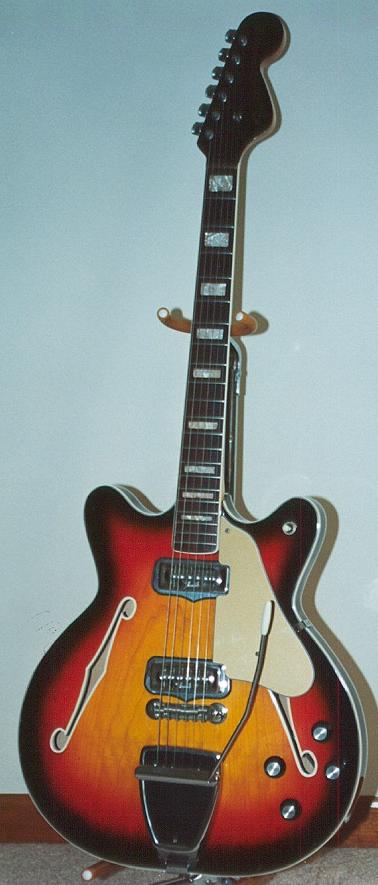
FACTOIDS & TRIVIA
The Coronado family of
guitars was Fender's attempt to capture part of the market enjoyed by
the Gibson ES series and the Guild Starfire series of thinline
semihollow electric guitars. It was designed by Roger Rossmeisl
(1927-1979), a German luthier that worked for Rickenbacker before
moving to Fender in 1962. Rossmeisl's guitar designs, such as the
Rickenbacker Combo series and Fender LTD, usually called for his
trademark German carve top. However, he chose to use a traditional
arched top on
the Coronado series. The DeArmond pickups are the first non-Fender
designed
pickups ever used on a Fender guitar. The Coronado series ran from late
1966 to 1972 and was short lived for two reasons: the pickups were not
very
powerful, and the completely hollow design was prone to feedback.
However,
it had the same comfortable neck profile as found on the late 1960s
Jazzmaster
and its sound is well suited for a variety of musical styles. The
Coronado
II pictured is unusual in that it has a 1-piece maple top and back,
instead
of the customary 2-piece top and back.

Body: Hollow; 1-piece laminated maple top and back, laminated maple sides; single bound top, back, and f-holes
Finish: Sunburst, nitrocellulose lacquer
Neck: 1-piece maple, bolt-on
Fingerboard: Indian rosewood, single bound; pearloid block markers
Number of Frets: 21
Pickguard: Gold/white/black/white plastic laminate
Bridge: Fender steel with vibrato tailpiece, chrome
Nut: Brass (non-original)
Tuners: Fender, enclosed, chrome
Pickups: Two, Fender/DeArmond single coil with adjustable pole pieces, chrome
Controls: Tone and volume controls for each pickup, 3-way pickup selector
Scale Length: 25 1/2 inches
Neck Width at Nut: 1 5/8 inches
Body Width at Lower Bout: 16 1/8 inches
Body Depth: 1 3/4 inches
Weight:
6.7 lb